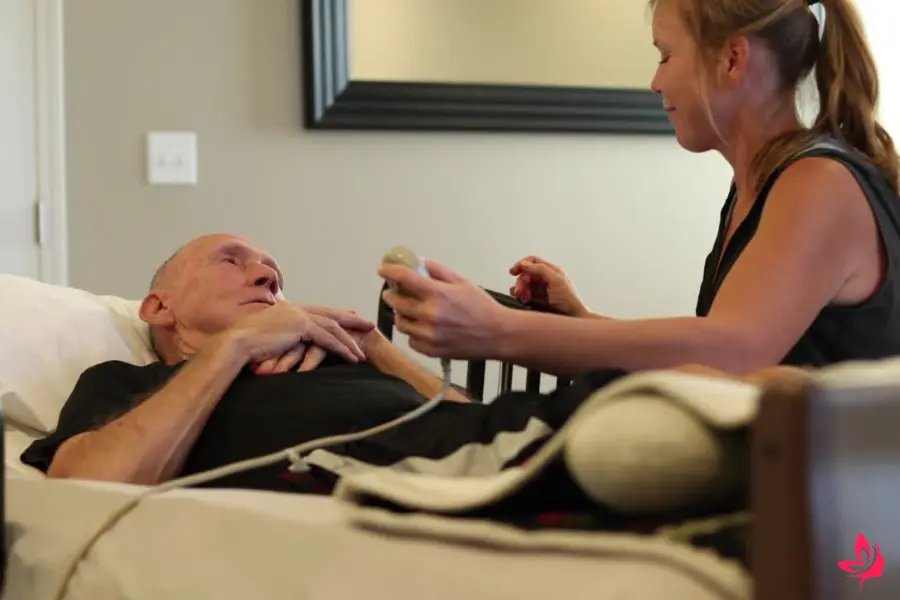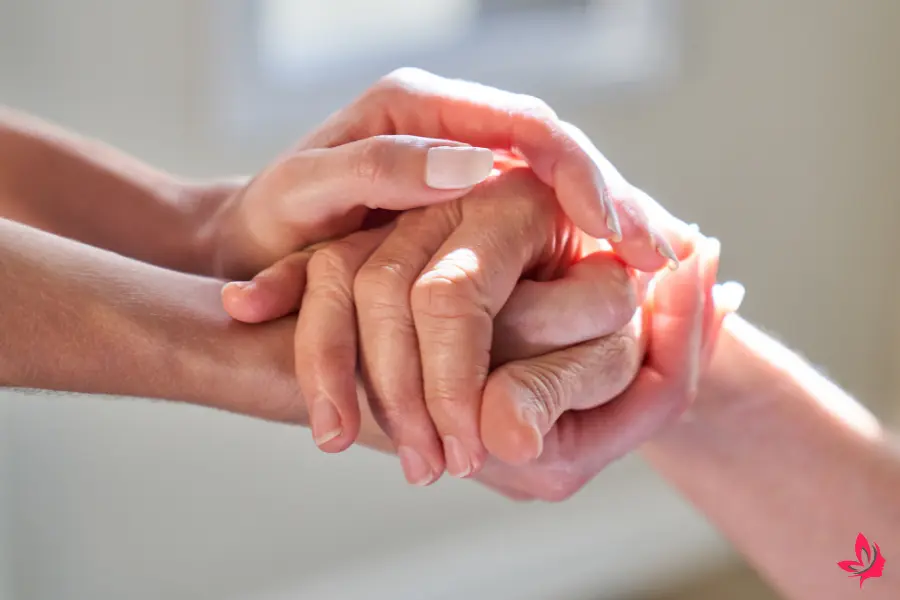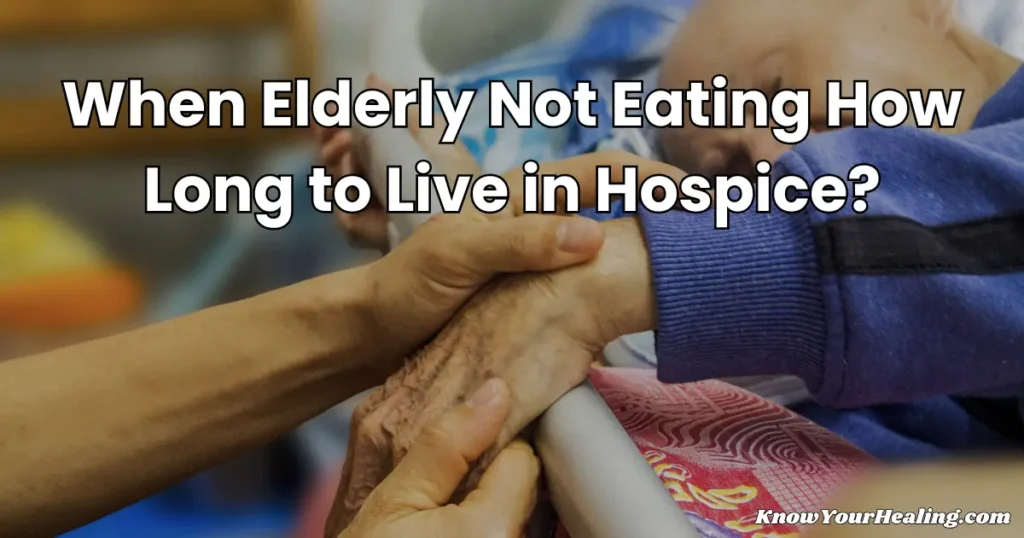When an elderly loved one stops eating in hospice, families face a harsh reality. It’s a moment that sparks urgent questions—how long do we have, and what should we expect?
Most hospice patients who stop eating live anywhere from a few days up to about 10 days, though some may last several weeks, especially if they’re still drinking fluids.
Understanding this timeline helps families brace themselves emotionally. It also lets them focus on what matters most in these final moments.
Stopping eating isn’t usually a choice. It’s a natural part of the body shutting down, not something that needs intervention.
This article digs into what influences how long elderly hospice patients survive without food. You’ll find guidance on comfort care, nutrition decisions, hydration, and ways to support your loved one (and yourself) during these last days.
Understanding the Timeline When the Elderly Not Eating How Long to Live in Hospice

Most elderly people in hospice survive about 10 days without food, but it can be as short as a few days or stretch to several weeks. A great deal depends on their health, hydration, and underlying medical conditions.
Hospice teams look for physical changes and focus on patient comfort. They try to give families realistic expectations, even though it’s never easy.
How Hospice Care Teams Assess Survival Time
Hospice nurses use specific assessments to estimate how long a patient may live without eating. They assess overall health, kidney function, and the presence of chronic illnesses.
Every day, the hospice nurse monitors vital signs and physical condition. They monitor changes in energy, track fluid intake, and note shifts in temperature, blood pressure, and breathing.
Diagnosis and disease stage matter. A person with late-stage dementia might have a different timeline than someone with cancer or heart disease.
The care team documents these details to help families know what’s coming. They also examine how the patient responds to comfort measures—some might accept ice chips, while others refuse everything.
Physical Changes in the Final Stages of Life
Physical changes show up in predictable ways when eating stops. The body struggles to process nutrients, and things start to slow down.
Common physical changes include:
- Low energy and sleeping more
- Dry mouth, less saliva
- Noticeable weight loss and muscle weakness
- Breathing changes—maybe slower or irregular
- Cooler skin, especially hands and feet
As fluid intake decreases, the kidneys slow down, which actually helps reduce discomfort. Many people feel less pain as their body gently shuts down.
The skin may turn pale or mottled, and the limbs may feel cool. These are typical signs that the end is near.
Role of Palliative Care in Comfort and Quality of Life
Palliative care is all about comfort. The team focuses on quality of life, not at the expense of extending it.
Mouth care becomes a priority to prevent dry mouth. They might use lip balm or offer ice chips if the patient can handle them.
Comfort measures include:
- Frequent oral hygiene
- Adjusting position to ease breathing
- Pain relief as needed
- Emotional support for the family
Feeding tubes or artificial nutrition usually aren’t recommended. These can cause more distress than relief.
Spiritual support steps in to help with emotional needs. Families receive guidance on how to care compassionately and maintain dignity at the forefront.
Life Expectancy for Elderly Individuals With Terminal Illness
Terminal illness changes how long someone survives without food. Cancer patients might live 1–2 weeks, while those with heart failure often have less time.
Dementia patients sometimes last longer—their bodies adapt to less food. Age matters too; younger patients might live longer than frailer elders with the same diagnosis.
Overall health before contracting the illness significantly impacts survival. Providers avoid giving exact timelines because there’s so much variation.
Some people live several weeks without food if they keep drinking, but hospice patients often face other complications.
Factors That Affect How Long Hospice Patients Live Without Eating
Several factors influence the survival time once eating stops. Medical conditions, medication side effects, and chronic illnesses all matter.
Key factors include:
- Nutrition status before stopping food
- How much fluid they’re taking in
- Existing health problems
- Mental health and outlook
- Room environment
Dehydration speeds things up more than lack of food. Without fluids, some patients pass within days, though 10 days is typical.
Medications can worsen appetite—some cause nausea or alter taste. Providers may adjust medications to help with comfort.
Room temperature and humidity matter more than you’d think. A peaceful environment, with family nearby, can ease emotional distress. That support shapes the whole experience.
Providing Comfort and Appropriate Care During the Final Days

When an elderly person in hospice stops eating, comfort becomes the primary focus. The care team works to keep them comfortable through mouth care, emotional support, and compassion—never by forcing them to eat.
Best Ways to Keep the Mouth Moist and Comfortable
Dry mouth is a big issue when eating slows down or stops. Good oral hygiene and keeping the mouth moist help prevent pain and infection.
Caregivers use damp sponges to clean the mouth every few hours gently. If it’s safe, ice chips bring some relief. Lip balm helps keep lips from cracking.
Sometimes, a few drops of fluid from a syringe or dropper can provide soothing relief. However, if swallowing becomes difficult, it’s best not to force it. The hospice nurse can demonstrate how to perform mouth care safely.
Regular cleaning keeps bacteria and food particles away. It’s a simple act that makes a huge difference in comfort.
Nutritional Support When Appetite Is Low
Losing appetite is a normal part of dying for many elderly hospice patients. The team focuses on comfort, not calories.
Food options that help:
- Softer meals that go down easily
- Milkshakes or smoothies for extra calories
- Finger foods in small amounts
- Old favorites that spark a little interest
Artificial nutrition or feeding tubes rarely help at this stage. The body can’t use food like it used to, and these interventions often cause more problems.
Meals should be small and appealing. Offering food when the patient is most awake is more effective than adhering to strict schedules. If meds are making things worse, the care team can adjust them.
Managing Emotional Needs for Patients and Family Members
Emotional needs run high for everyone involved. Palliative care teams offer spiritual support and counseling to help with fear or grief.
Families often struggle when a parent stops eating. It’s hard not to try to help by offering food, but forcing it can add distress. Education helps families accept this natural part of dying.
Support strategies that matter:
- Open, honest updates about the patient’s condition
- Counseling for loved ones
- Spiritual care tailored to beliefs
- Making time for meaningful moments together
The hospice team helps families process grief while keeping the patient’s comfort and dignity at the center of care.
Appropriate Care Plans at the End of Their Life
Care plans focus on comfort, not aggressive treatment. Providers develop these plans based on the patient’s condition and their wishes, if known.
Teams monitor kidney function and overall health without invasive tests. They track fluids and energy to adjust comfort measures as needed.
Pain management and symptom control are priorities. Providers avoid anything that could add suffering. They regularly reassess care needs, as circumstances can change quickly.
Conversations about care goals are key at this stage. Families and patients work together to set priorities for the time left.
Comfort Measures for Hospice Patients in the Final Stages
As the end nears, the hospice team steps up with targeted comfort interventions. Patients may live from a few days to two weeks after eating stops, so comfort matters most.
Essential comfort measures include:
- Changing positions to prevent bedsores
- Gentle massage for circulation
- Soft music or familiar voices for calm
- Blankets to keep warm
Consciousness usually fades, and breathing changes. Family can offer comfort through touch or simply being present. Hospice nurses watch closely for any signs of distress.
Creating a peaceful, familiar space helps preserve dignity. Ongoing symptom management is crucial, especially for those with chronic conditions. The team’s goal is to keep the patient comfortable through their final hours.
What Families Should Know About End-of-Life Nutrition and Hydration

It’s common for elderly hospice patients to eat and drink less as they approach the end of their lives. Families need clear information about what’s normal, what to expect, and how to provide compassionate care during these challenging times.
The Normal Part of Reduced Appetite at the End of Life
Losing interest in food is part of the body’s natural shutdown. As energy fades and health declines, eating becomes less important.
Providers explain that decreased eating at the end of life can be distressing for families. But pushing food often causes more harm than good.
Why does appetite fade?
- Medication side effects that change how things taste
- Dry mouth from less saliva
- Dental issues making chewing tough
- Chronic illnesses that slow down digestion
- Mental health changes that sap interest in eating
Dementia patients, especially, may lose their appetite weeks before the end. In late stages, they might refuse food entirely. The hospice team reminds families that this is the body’s way of preparing for death. Fighting it rarely brings comfort or quality of life.
How Long Hospice Patients Can Survive Without Food or Water
Survival time without food in elderly hospice patients varies a lot. No one can predict the exact time frame because everyone’s different.
Health care providers report that some patients survive weeks, days, or just hours after they stop eating. When water intake stops, the timeline usually shortens even more.
| Condition | Typical Survival Time |
|---|---|
| Without food | 1–3 weeks |
| Without fluids | 3–7 days |
| With small amounts of fluid | Sometimes longer |
Physical condition and kidney function play significant roles in how long someone lives. If an elderly person has chronic health issues, survival can be shorter.
Hospice nurses closely monitor vital signs and help families establish realistic expectations. Occasionally, someone might live longer than anyone guessed.
Deciding on Artificial Nutrition or Tube Feeding
Artificial nutrition—such as feeding tubes—requires careful consideration of comfort and the patient’s preferences. Forcing food or fluids can actually make dying harder.
Most healthcare teams steer away from tube feeding in the final stages because of:
- Higher risk of aspiration pneumonia
- Added discomfort from the procedure
- Minimal impact on survival
- Disruption of the natural dying process
The care team reviews each case individually. Sometimes tube feeding is suitable if it aligns with the patient’s wishes and physical health.
Families should discuss these choices with their healthcare provider early on. The first step is to understand what the person wants for their care.
Communication Between Hospice Care and Family Members
Open, honest talks between hospice staff and families make care more personal. Professionals offer emotional support and explain what’s happening as needs change.
Hospice nurses educate families about the normal changes that occur during end-of-life care. They explain why people eat less and offer suggestions on how to address the issue.
Key communication topics include:
- How much time may be left, based on the current condition
- Simple comfort measures like ice chips and lip balm
- How to keep the mouth clean and moist
- Supporting emotional needs
Regular updates help friends and family feel more prepared. The care team also shares what to expect in the last hours.
Spiritual and emotional support are crucial during this time. Families can ask about soft foods or easier meal options if needed.
Supporting the Elderly Parent or Loved One Through the Final Days
In the last days, comfort matters more than nutrition. Small sips of water or ice chips can soothe without forcing food.
The best ways to support a dying loved one:
- Offer finger foods in small portions if wanted
- Keep the mouth clean for comfort
- Be present and offer emotional support
- Respect their choice to refuse food or drink
Palliative care focuses on quality of life, not just survival. Family can offer milkshakes or favorite snacks, but without pressure.
Appetite loss occurs when the body naturally shuts down. Knowing this helps families accept the changes they see.
Hospice providers guide families through moments when the person might want a sip or bite, but they always respect the person’s declining needs.
Frequently Asked Questions
Families often ask what to expect when an elderly loved one stops eating in hospice. Most patients can live without food for about 10 days, but this duration can be shorter or longer.
Most hospice patients live about 10 days after stopping food. Some pass in a few days, while others hang on for weeks. The timeline depends on health and hydration. Underlying health and energy reserves make a difference.
Breathing often becomes irregular, with long pauses between breaths. Body temperature drops; hands and feet may feel cold. The skin can turn bluish, especially around the lips and fingertips. Many people become less responsive, sleeping almost all the time.
Older adults experience natural changes in appetite and digestion. They might feel full faster and lose interest in food flavors. Common health problems and medications can lower hunger or make food unappealing.
Depression and loneliness also affect appetite. Difficulty chewing or swallowing makes eating tough for some. These changes are often a natural part of aging, not just a result of illness.
Organs start slowing down within days after food stops. The body burns fat and muscle for energy. The digestive system shuts down first. The kidneys and liver slow down within a week. The heart weakens over time, while the brain usually remains sharp for a bit longer. It’s a gradual process for most.
Dry mouth and sticky saliva appear early. The tongue can look darker or more coated. Skin loses its bounce and may stay pinched. Eyes might look sunken or hollow. Urine output drops and darkens. Some people stop urinating entirely in the last days.
The body begins shutting down naturally. Energy drops, and the person sleeps more. Weight loss accelerates as the body utilizes stored energy. Mental clarity can come and go. Physical weakness increases, moving harder. The immune system loses its strength, making infections more likely.
Yes, appetite often fades as part of the dying process. Most hospice patients stop wanting food as their body prepares for death. Hospice care chooses comfort over nutrition. Forcing food can cause discomfort and doesn’t extend life. The body’s lower need for food protects the patient. Most people don’t feel pain from not eating at this stage.
Hospice teams focus on comfort, not just survival. Artificial feeding can cause more harm than good for dying patients. Force feeding risks choking, pneumonia, or digestive issues. The body can’t handle much food or fluid near the end. Loss of appetite is a normal part of dying. Respecting this helps reduce suffering and maintains dignity.
More sleep and less alertness signal a decline. Confusion or disorientation can increase. Eating and drinking drop off. Weight loss can happen quickly. People may withdraw socially and lose interest in activities. Every day tasks become much harder due to weakness.
Elderly patients in hospice typically survive 1-2 weeks without eating. That range can shift depending on their overall health and the amount of water they’re getting. Some people may live only a few days after they stop eating. Others, especially those with more strength or fewer health issues, might last several weeks.




